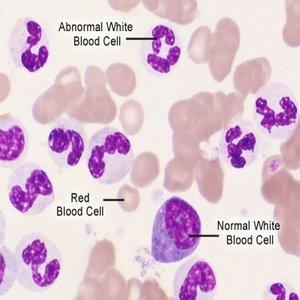What is the full form of CMLCML: Chronic Myelogenous LeukemiaCML stands for Chronic Myelogenous Leukemia. It is also called chronic myeloid leukemia. It is a type of cancer that affects the blood and bone marrow. It causes the bone marrow to produce a large number of myeloid (immature white blood cells), which are also known as blasts or leukaemic blasts. These cells crowd the bone marrow in a way that interferes with normal blood cell production. CML progresses slowly than other forms of leukemia. In some cases, it may change into a fast-growing (acute) leukemia. In the beginning, it affects the myeloid then affects the blood and spreads to other parts of the body. CML is more common in men than women and its risk increases as a person gets older. 
Symptoms:
Causes:It occurs due to some unfavorable changes in the genes of myeloblasts, i.e. An abnormal chromosome in bone marrow cells (myeloblasts) called the Philadelphia chromosome. It is not clear what causes this change. But, there are certain factors that may increase the risk of developing CML, such as:
Its diagnosis is based on the histopathologic findings in the peripheral blood and Philadelphia chromosomes in bone marrow cells. There are three phases/stages of CML: Chronic phase: In this phase, the patients have a small amount of immature white blood cells (myeloblasts), less than 10%, in their bone marrow or blood. They experience mild symptoms like tiredness, weight loss and swollen tummy. In this phase, the patients respond positively to standard treatments. Accelerated phase: In this phase, the symptoms are more apparent and the patients have more than 10 percent but less than 20 percent myeloblasts in the bone marrow or blood. The blood basophil increases in number, rises to more than 20% of the total white blood cells. Blast phase: It is also called acute phase, blast crisis and blast transformation. In this phase, the leukemia changes into an acute leukemia. The patients usually have more than 20 percent myeloblasts in the bone marrow or blood. It may spread to other parts of the body after affecting the bone marrow.
Next TopicFull Form
|
 For Videos Join Our Youtube Channel: Join Now
For Videos Join Our Youtube Channel: Join Now
Feedback
- Send your Feedback to [email protected]
Help Others, Please Share










